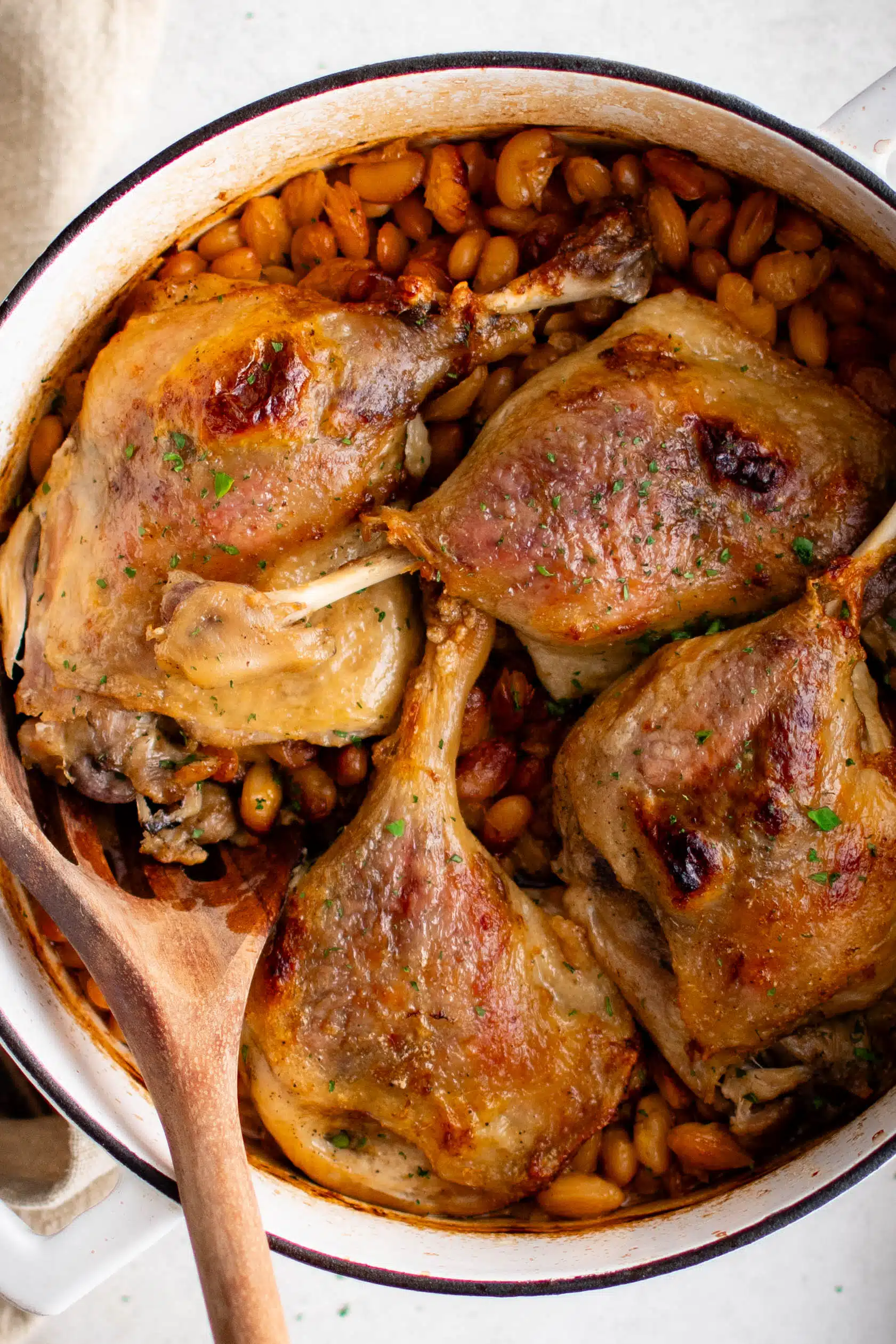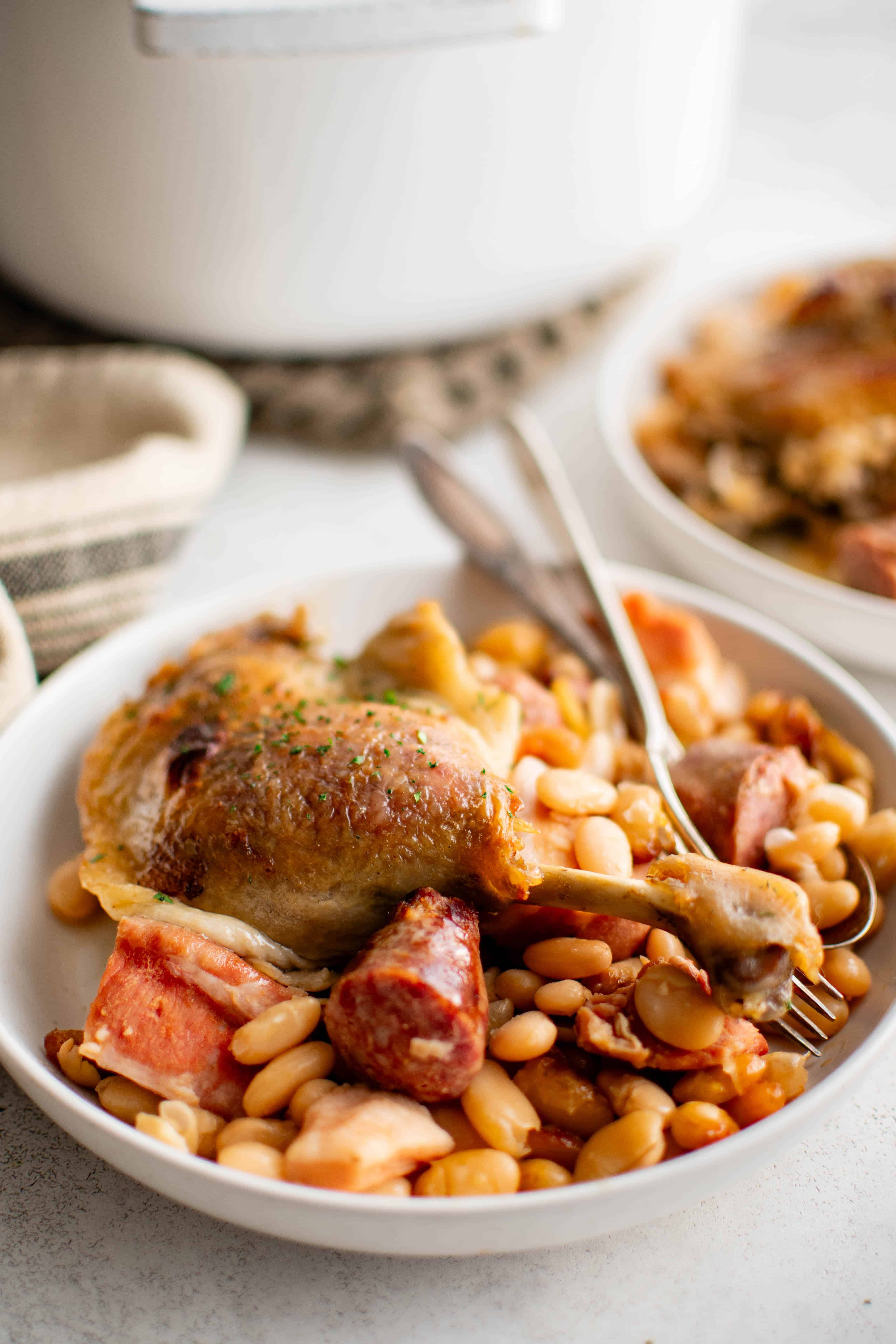This post may contain affiliate links. See my disclosure policy.
This traditional French Cassoulet Recipe is a hearty, delicious, meaty stew filled with duck, pork, sausage, and beans slowly cooked in a rich and flavorful tomato broth. Perfect with a loaf of crusty bread.

Traditional cassoulet is like a journey back in time. Comforting, simple, and delicious, the most important thing to know before getting started with this dish is that it is a process. It takes time—days, in fact. But, the process is easy and well worth the wait.
What is Cassoulet?
Cassoulet is a traditional slow-cooked stew-like casserole that originated in 1355 in the town of Castelnaudary, South France. At its core, cassoulet is a medieval peasant dish designed to make do with whatever was available at the time.
It gets its name from the French word “cassole“, a type of deep, round, earthenware cooking pot. Though easy to make, cassoulet cooks slowly. Traditional recipes would have taken at least two days to make.

Cassoulet Ingredients
This is a traditional cassoulet recipe anyone can make! It includes two types of pork (pork belly and Italian pork sausages), ham hocks (to flavor the homemade stock), duck legs (that we’re going to use to make duck confit), and dry cannellini beans (as haricot lingot beans are hard to find here in the States).
Many traditional cassoulet recipes would have included duck confit. Duck confit is a French dish made from duck legs that have been slowly cooked in their own fat. Historically, the method of cooking meat in its own fat and then storing it submerged in the same fat was used to preserve meat. Rather than buying duck confit from the grocery store (very hard to find), we’re going to make our own.
At first glance, the ingredients may seem overwhelming – especially to those of us here in the US, where some of the traditional ingredients may be impossible to locate. Fortunately, there are plenty of substitutions and many more regional variations to draw inspiration from.
- Meats: The most commonly used meats include pork sausages, pork (skin, belly, or shoulder), mutton, goose, duck, or partridge. In more recent years, chicken and turkey may be used in place of some of the more traditional poultry options. The meat you choose to add, however, is free game (pun intended – ha!), so I recommend including what you love.
- Dried White Beans: Traditionally, cassoulet is made with haricot lingot beans or Tarbais beans as they hold their shape throughout the long cooking process and have a creamy texture. Suitable substitutions include flageolet beans, Great Northern beans, or cannellini beans.
- Vegetables and Aromatics: Onion, garlic, carrot, tomatoes, and tomato paste.
- Bouquet Garni: Also known as an herb and spice sachet. This recipe calls for fresh parsley, thyme, cloves, rosemary, bay leaves, and peppercorns.
- Broth or Stock: Chicken, pork, or vegetable stock, plus a little red wine vinegar, too.
- Duck Fat: In this recipe, duck fat (plus olive oil) will be used to confit the duck legs and brown the pork sausages.
Duck Alternative: If you prefer not to go through the process of making duck confit, you have two options: Sear the duck legs in duck fat until the skin is golden brown, then nestle them into the beans and allow them to cook slowly with the layered beans and meat. The other alternative is to swap the duck legs for bone-in skin-on chicken. Sear the chicken in duck fat (yes, you really want to use duck fat somewhere in this recipe), then nestle them into the beans and allow them to cook slowly with the layered beans and meat.

How to Make Cassoulet
1. Soak the Beans and Season the Duck: Add the beans to a large bowl, cover with water, and soak overnight. Meanwhile, place the duck legs on a large plate and season with thyme, orange zest, salt, and black pepper. Refrigerate the duck and soak the beans overnight. The next morning/day, brush off as much of the seasoning from the duck as possible before proceeding.


The next day.
2. Preheat the oven to 200 degrees Fahrenheit and drain and rinse the beans.
3. Bake (Confit) the Duck Legs in Duck Fat: Melt the solidified duck fat over medium heat, then stir in the olive oil. Place the duck legs into a large baking dish and cover with the liquified duck fat and olive oil. Slowly cook in the oven for 4-5 hours, spooning duck fat over the exposed skin at least every hour.
4. Refrigerate the Duck Confit: Remove the duck from the oven and allow it to cool to room temperature, then remove it from the fat to a clean airtight container. Transfer to the refrigerator overnight. Note: Reserve at least half a cup of the duck fat in a small jar or container and keep it stored in the refrigerator.



The next day.
5. Assemble the Herb Sachet: Prepare an herb sachet/bouquet garni with the whole parsley, thyme, cloves, rosemary, bay leaves, and peppercorns, or wrap them in cheesecloth and secure it with butcher’s twine.


6. Prepare the Homemade Stock: Add the drained and rinsed beans, chicken stock, pork belly, garlic, ham hocks, tomatoes, onion, carrot, celery, red wine vinegar, tomato paste, salt, and the herb bag to a large pot. Bring to a boil.
7. Simmer: Reduce heat to low, cover the pot with a lid, and allow the broth to simmer for 30-45 minutes or until the beans are tender. Use a small fine-mesh strainer to skim off any scum that settles on the top of the broth. Once the beans are tender, remove from heat. Carefully remove the pork belly to a clean cutting board.



8. Brown the sausage: In a large skillet, brown the sausages in reserved duck fat over medium-high heat- they do not need to be fully cooked. Transfer the sausage to the same cutting board as the pork belly. Chop the pork belly and sausage into large chunks.


9. Layer the “Casserole”: In a separate oven-safe pot or Dutch oven, place the chopped-up meat on the bottom. Drain the beans from the homemade stock with a slotted spoon and layer the beans on top of the meat. Finally, strain the stock from the first pot through a fine-mesh strainer. Add just enough stock to the pot to barely cover the beans.
10. Preheat the Oven to 325 degrees Fahrenheit.



11. Bake: Bake the prepared cassoulet uncovered for one hour, then break the crust that forms on the top of the beans by gently tapping it with the back of a spoon. Pour in more broth – not too much – just enough to cover the beans. Repeat two more times, baking the beans for 30 minutes between each broth addition. Remove from the oven.
Note: Remove the duck from the refrigerator just before the last addition of stock. This will give the duck enough time to reach room temperature by the time the cassoulet is ready to come out of the oven.



12. Broil the Duck Confit: Line a large baking sheet with aluminum foil and set the oven to broil. Place the duck confit (the baked duck legs) on the baking sheet and broil for 5 minutes or until the skin is golden and crispy.


13. Serve: Transfer the duck legs to the pot and place them gently on top. Serve with French bread and salad, if desired.
How to Serve French Cassoulet
Cassoulet is most often served with the following:
- Bread: Ah, yes! Of course, there must be bread! And a nice crusty French baguette or country-style bread is just the thing to soak up the rich sauce.
- Salad: A light, simple green salad with a tangy vinaigrette dressing helps balance the heaviness of the dish.
- Pickles or Cornichons: I had no idea what cornichons were until I traveled to France. And let me tell you, these mini little cucumbers were served with just about every meal I ate there. Better than regular-size pickles, they’re less juicy and perfectly tangy.
- Mustard: I have not tried this for myself, but I imagine it would taste fantastic with the pork belly and sausages.

Cassoulet with a Breadcrumb Crust
Some versions of cassoulet are finished with a golden breadcrumb topping to create a crusty layer when baked. I chose not to add any breadcrumbs to this recipe, but if it sounds like something you’d enjoy, sprinkle approximately one cup of your favorite store-bought or homemade breadcrumbs over the top of the cassoulet before adding the duck legs to the top of the dish. Broil for 3-4 minutes or until golden brown. Remove from the oven and nestle the duck legs into the dish as outlined.
Should Cassoulet Be Soupy?
Typically, cassoulet isn’t soupy. It should be moist with rich and tender beans and meats that are soft and succulent, all surrounded by a flavorful sauce. However, it shouldn’t be overly watery or soupy. If you find your dish with too much liquid, it could be from:
- Too much liquid from the beans: Soak your beans overnight for best results. This will allow the beans to absorb enough cooking liquid, preventing the cassoulet from turning out too wet.
- Not enough cooking time: Traditional cassoulet is slowly cooked, allowing the flavors to meld and the excess liquid to evaporate.
- Too much broth: It’s important not to add too much stock all at once.

Storage and Reheating
Storage: Allow leftovers to cool before transferring to one large or several smaller airtight containers. Store the leftovers in the refrigerator for up to 3-4 days.
Freezing: You may also freeze leftovers. Transfer it to freezer-safe containers or heavy-duty freezer bags. Properly stored, cassoulet can last in the freezer for 2 to 3 months.
Reheating: From frozen, thaw in the overnight in the refrigerator overnight before reheating. To reheat, cook leftovers on the stovetop over medium heat or in an oven preheated to 350°F (175°C). If reheating in the oven, cover the dish with aluminum foil to prevent it from drying out. If it’s dried out a bit upon reheating, add a splash of broth or water.

More French Recipes
- Crêpe Recipe
- Bouillabaisse Recipe
- Beef Bourguignon (French Beef Stew)
- Chicken Fricassee
- Quiche Lorraine

Cassoulet Recipe
Ingredients
- 1 pound dry white beans, haricot lingot beans, flageolet beans, Great Northern beans, or cannellini beans.
- 4 large duck legs
- 1 orange, zested
- 5 sprigs fresh thyme, divided
- 4 teaspoon salt, divided
- 1 cup duck fat
- 1 cup light olive oil
- 3 sprigs fresh parsley
- 3 whole cloves
- 2 sprigs fresh rosemary
- 2 bay leaves
- 1 teaspoon black peppercorns
- 6 cups chicken broth
- 1 pound pork belly, cut into 5-6 large pieces
- 5 cloves garlic, peeled
- 2 ham hocks
- 3 large tomatoes, halved or quartered
- 1 onion, peeled
- 1 large carrot
- 1 stalk celery
- 2 tablespoon red wine vinegar
- 1 tablespoon tomato paste
- 3 Italian sausage
Instructions
Day 1
- Soak the beans: Add the beans to a large bowl, cover with water, and soak overnight.
- Season the duck legs: Mince two sprigs of thyme and zest the orange. Season the duck legs with thyme, orange zest, salt, and black pepper.
- Refrigerate overnight: Cover and transfer the duck legs to the refrigerator. Refrigerate overnight. The next morning/day, dust off as much of the seasoning as possible before proceeding.
Day 2
- Preheat the oven to 200 degrees Fahrenheit. Drain and rinse the beans.
- Melt the duck fat: In a large pot, melt the duck fat over medium heat, then stir in the olive oil.
- Bake (confit) the duck legs: Transfer the duck legs to a large baking dish. Cover with the heated oil and duck fat. Transfer it to the oven and bake for 4-5 hours, spooning the duck fat over the exposed skin at least every hour.
- Refrigerate the duck overnight: Remove the duck from the oven. Cool to room temperature and then remove it from the fat. Chill in the fridge overnight. *Reserve some of the remaining duck fat in a small jar or container in the refrigerator*
Day 3
- Assemble the bouquet garni: Prepare an herb sachet with the whole parsley, thyme, cloves, rosemary, bay leaves, and peppercorns, or wrap them in cheesecloth and secure it with butcher's twine.
- Prepare the broth with the beans: Add the drained and rinsed beans, chicken stock, pork belly, garlic, ham hocks, tomatoes, onion, carrot, celery, red wine vinegar, tomato paste, salt, and the herb bag to a large pot. Bring to a boil over medium-high heat. Use a small fine-mesh strainer to skim off any scum that rises to the top of the broth.
- Simmer: Reduce heat to low, cover the pot, and allow the broth to simmer for 45 minutes or until the beans are tender. Stir occasionally. Once the beans are tender, remove from heat. Carefully remove the pork belly to a clean cutting board.
- Brown the sausage: In a large skillet, cook the sausages in reserved duck fat over medium-high heat until brown and charred on all sides. Transfer the sausage to the same cutting board as the pork belly. Chop the pork belly and sausage into large chunks.
- Build your "casserole": In a separate oven-safe pot or Dutch oven, layer the meat on the bottom, then drain the beans from the stock with a slotted spoon and layer on top of the meat. Strain the broth from the first pot and pour in just enough to barely cover the beans.
- Preheat the oven to 325 degrees Fahrenheit.
- Bake the beans: Bake the beans uncovered for one hour, then break the crust that forms on the top of the beans by gently tapping it with the back of a spoon. Pour in enough broth to cover the beans, and repeat, baking the beans for 30 minutes later, breaking the crust, adding broth, and baking for another 30 minutes.
- Remove the pot from the oven and set the oven to broil: Line a large baking sheet with aluminum foil.
- Broil the duck legs: Place the duck confit (the baked duck legs) on the baking sheet and broil for 5 minutes until the crust is golden.
- Serve: Transfer the duck to the pot and gently place them on the beans. Serve with French bread and salad, if desired.
Notes
Nutrition
Nutrition information is automatically calculated, so should only be used as an approximation.














